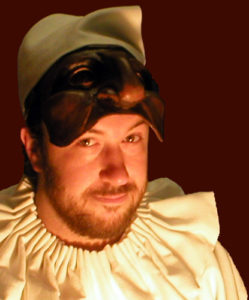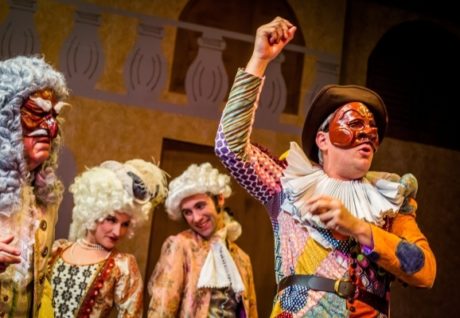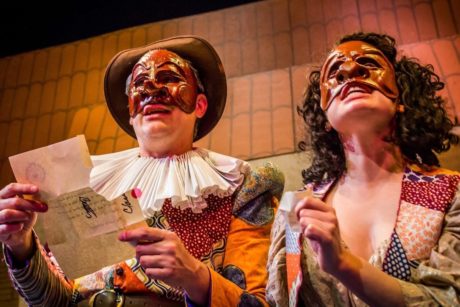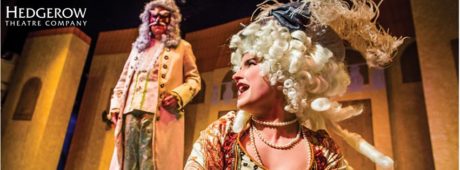Here is the second of two interviews with Aaron Cromie, one of Philadelphia’s most beloved directors, mask makers, writers, and interdisciplinary theater artists.
Henrik: Carlo Goldoni (1707-1793) went beyond “the comedy of masks and the comedy of intrigue” by focusing on actual life and behaviors of his contemporaries in ways that had not been seen before. He added his own wit and honesty, and created a new form of Italian comedy. Looking at your production, how are you following in his footsteps, or are you perhaps reinventing Goldoni?

Aaron: My version of the Goldoni play is replete with possibility. I’ve learned a lot about structure from his model in this play. My hope is that I’ve honored Goldoni’s play, found a way to connect with our audience, and collaborated with the actors, stage management, and designers to make a fresh take on the play.
Could you give an example or two where the actors or members of the artistic team impacted your production?
I think the catch-all answer here is that each cast member has a silly and funny character choice—making the others laugh—so that initially set the bar. Each time we got more confident and off book with the material, the size and ridiculousness of the characters began to grow in reaction to each other. The actors all pushed each other through the process. Kayla Speedy’s wigs and costumes really helped fill out the comedy. The actors got even funnier in those creations.
As a highly innovative director, what do you do to attract contemporary audiences?
I appreciate the compliment, but the credit goes to the collaborative process and all of the people involved. As a maker, it’s my job—and the job of other artists—to make the art we want to see. There are always challenges of inclusion, diversity, and pushing the envelope, but we live in a time when there must be movement in all aspects of the art spectrum to create accessible theatre that tell stories about all kinds of people and experience.
Tell us how you go about working with actors, administrators, and the artistic team—in this case, using the collaborative process at the Hedgerow Theatre.
Play. Play. Play. If something worked in the first read through—if the table read had laughs—I built from there. If it didn’t work, we cut liberally. Many actors, designers, and other collaborators made offerings, improvisations, and suggestions, so we revised throughout the process.
Could you give an example or two where actors and members of the artistic team made recommendations that you integrated into your production?
Jared Reed [The Artistic Director of the Hedgerow Theatre, playing Truffaldino Battocio] gets credit for the dinner scene ad libs—which have now made it into the script—but I don’t want to spoil the laughs. Brock [Vicker]’s chest hair was a distinctly important contribution.
You have worked with actors and the creative team at the Hedgerow as a guest director in the past. What do you remember of those experiences and what do you perhaps want to do differently this time?
The Hedgerow community really makes me feel welcomed and appreciated, and everyone there works hard to make each next show special. This is my third collaboration, and I’m happy to see how the ensemble really works with what each production needs, rather than just having one method of rehearsing a project.
Reflections: Going beyond getting praised and pigeon-holed
When you look back on your life as an actor, puppet-master, and director, what would you say were the highlights in your life?
I’m far from a puppet-master to be sure, but I’m very grateful to have had a career that began as a musician, then on to an actor, from there to designer of masks and puppets, and for some time now, working as a director and writer. Philadelphia has been very kind to me, and I feel lucky to be able to do all kinds of things to make a life in art.

Similarly, what were the three things you struggled with the most in your life?
Making the mortgage is always a challenge, as there is no consistency in scheduling a season. I’ve been lucky to make it work, but it is a constant hustle, and I have to do a lot of things to make it work.
Another is being sometimes pigeon-holed as the “puppet guy” or the “commedia guy.” I’m definitely excited by that work, but I think sometimes people don’t see that artists are capable of more than the one or two things they are most known for. My friend and collaborator Kittson O’Neill recognized and encouraged my interest in scenic design, and I had the chance to work for Hedgerow, designing for her production of [Eric Overmyer’s] On the Verge last season. It was gratifying to have her believe in me.
Lastly, being busy making masks and things: my house is always in need of cleaning.
What are your plans for the next few years?
I’d love to do more adaptation and collaboration projects with ensembles—not unlike this production. I have a few devised projects I’d like to make. Also, I’ve been playing music with local performer Emily Schuman with our folk and acoustic duo Chickabiddy. We recently recorded our first EP, and we’d like to tour our music. Lastly, I’d love to write more theatrical music with Emily. We are currently collaborating with the Almanac Dance Circus Theatre on a project for the Fringe Festival this fall.
Would you be willing to share one thing that only your best friends know about you?
I make an excellent zucchini pasta sauce. Learned it from my friend, Fabrizio, in Italy.

I heard that you actually did research at the Goldoni Institute in Venice. Is that true?
True. Venice is a magical place. I had the chance to travel there on several occasions—visiting my friend and collaborator Fabrizio Paladin, an incredible commedia practitioner and pedagogue—to do research in the Goldoni Library many years ago. Every person should walk down those streets to take in the sights, sounds, and tastes of that magnificent city.
For all those who can’t make it to Venice, let them go and see Goldoni’s Servant of Two Masters at the Hedgerow Theatre—the second best thing to meeting with commedia practitioners in Italy. Thank you, Aaron, for bringing classical Italian theatre back to life in the greater Philadelphia area.
Running Time: Two hours, including a 10-minute intermission.
The Servant of Two Masters, plays through June 26, 2016 at the Hedgerow Theatre Company – 64 Rose Valley Road, in Media, PA. For tickets, call (610) 565-4211, or purchase them online. Performance are on Fridays at 7:30 pm, Saturdays at 4:00 pm and 8 pm.
LINK:
‘Riffing, Replacing, and Reworking Goldoni’s “Servant of Two Masters‘ at the Hedgerow Theatre: An Interview with Director Aaron Cromie: Part 1.





